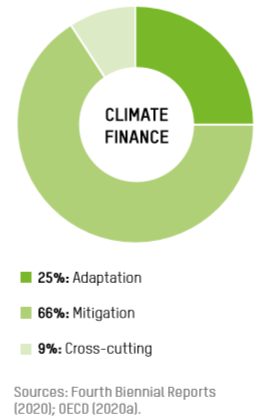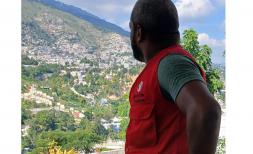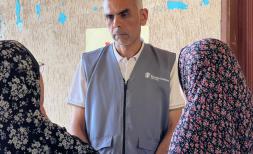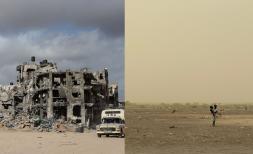5 years on from Paris – Is Climate Funding Failing the World’s Most Vulnerable Children?

Children are the least responsible for the climate crisis, but they will bear the greatest burden of its impact. For children in lower-income countries – there is a double burden. Low-income countries have contributed little to rising emission levels, but are often on the frontline of increasingly extreme weather events, while having less ability to protect their citizens, including children[1]. The Climate Crisis is a Child Rights crisis – for every child, but especially those vulnerable children growing up in low-income environments.
But this isn’t a problem for the future – it’s happening now. From more frequent and intense cyclones, heat waves, and wildfires, to the slowly rising sea levels – we are already seeing destruction and loss of lives and livelihoods across the world. This is a lived reality for millions of children. The ongoing COVID-19 pandemic has only made things worse - increasing poverty, inequality, and humanitarian need. As Save the Children’s recently released Humanitarian Appeal for 2021 says – “Children Cannot Wait”.
Children all over the world are highly aware of the hand they have been dealt. They are demanding change – and it is time that world leaders listen. One child told us “the hopes of one billion children are in your hands. Remember that when you take your climate action plans.”
Children speak up ahead of the Climate Ambition Summit as a part of Save the Children's Red Alert campaign.
Climate financing does not reach the most vulnerable
The commitment of member states to $100 billion of climate financing is a crucial part of the Paris Climate agreement. There remains a funding gap of billions of dollars to hit the 2020 target – with the UN Secretary General on 10 December calling on rich countries to fulfil their commitments. The increasingly worrying question is how climate funding is being spent. A crucial part of Paris Agreement is to fund what is called ‘adaptation’ in developing countries – these are measures that are needed to help countries, communities, families and of course children cope with the changes that will happen as a result of the climate crisis. Far too little of that funding is reaching the people that need it most – including children.
According to a recent report by Oxfam, only about 25% of reported public climate finance was for adaptation in 2017-18 and just 20.5% went to the least developed countries. A recent study by IIED found that in Bangladesh rural families had already spent more on adaptation than the government.

Global shares of mitigation, adaptation and cross-cutting finance in 2017-18.(Source: Oxfam).
The case for investing in children
Without strong adaptation measures, children risk being locked into poverty. And children are particularly vulnerable - even short periods of deprivation during the crucial years of childhood could have life-long impacts on their future potential.
We do have some ways to address this – by ensuring governments continue to invest in children, and help build their ‘human capital’. This will ensure children are better placed to cope with the uncertain future – and contribute positively to the new jobs and new economies we will need to create a future world that can sustain improved human well-being along with planetary health that underpins it. Investing in children is already one of the most sensible economical investments that governments can make.
How to do it?
One way of achieving this aim is to set up national systems to provide cash grants to families with children – especially young children. These systems have numerous benefits. To be most useful in the climate context they should also be universal (i.e. for every child), gender sensitive (possibly linked to other forms of support to address power dynamics – as often grants go to women as the primary care giver), and ideally automated so they can respond quickly and easily to shocks. This would allow governments to quickly, and efficiently, expand benefits on a temporary basis.
The world committed to protecting children from poverty and hunger in the Convention on the Rights of the Child and the Sustainable Development Goals.[2] Without these ‘social protection systems’, we risk continuing to need short-term, and expensive, humanitarian responses depending on the charity of others. Children deserve better than that – they deserve to have their needs met consistently and predictably. It is their right. The initial investments needed to set up these systems and ensure they are shock-responsive could potentially come from donors, including climate finance mechanisms.
Piloting shock-responsive social protection in Somalia
Somalia is a country coming out of decades of conflict and insecurity, layered on top of cyclical and increasingly severe climate shocks, including recurring droughts and floods. After the recent extreme flood events Fatun* 7, told us “the flood took away our goats. Now we have three but before we had more. I used to help the goats.” Overall, 49% of Somalis are unable to meet their food requirements even if they spend all of their money on food.
In Somalia, Save the Children has started four shock responsive safety net pilots. Each pilot relies on agreed early warning indicators that are triggered through a consultative process. By having systems in place, we have been able to deliver cash for people in need just six days of triggering response. These shock responsive mechanisms, in many ways, really form the bridge between longer-term development initiatives that aim to build government owned and led social protections scheme, and humanitarian cash that responds to crises. This work we hope to expand further in Somalia in coming years.

Residents of Baladweyne affected by the floods escaping on donkey cart. Thousands of people have been left displaced due to flooding in the worst-affected area of Beladwayne, Somalia.
Despite the catastrophic implications for children’s rights posed by the climate crisis, as well as the growing global movement of children calling for ambitious climate action, children and their rights are conspicuously absent from climate discussions, commitments and policies. Children’s views and rights should be central – and cover both the need to address the root causes of the crisis (mitigation) but also ensuring that adaptation finance benefits children – particularly the most vulnerable.
As the UN-UK Climate Summit “the sprint to Glasgow” starts this Saturday 12th December, Save the children asks world leaders to put children and their rights at the centre of climate discussions, commitments and policies.
[1] A recent report from Oxfam and the Stockholm Environment Institute found that the wealthiest 1% of the world’s population were responsible for the emission of more than twice as much carbon dioxide as the poorer half of the world from 1990 to 2015, according to new research.
[2] Convention on the Rights of the Child states the following: Article 26: States Parties shall recognize for every child the right to benefit from social security, including social insurance, and shall take the necessary measures to achieve the full realization of this right in accordance with their national law. Article 27 States Parties recognize the right of every child to a standard of living adequate for the child's physical, mental, spiritual, moral and social development.
SDG Target 1.3 states: 1.3 implement nationally appropriate social protection systems and measures for all, including floors, and by 2030 achieve substantial coverage of the poor and the vulnerable







